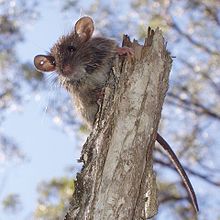Rattus fuscipes
| Bush rat | |
|---|---|
 |
|
| Scientific classification | |
| Kingdom: | Animalia |
| Phylum: | Chordata |
| Class: | Mammalia |
| Order: | Rodentia |
| Family: | Muridae |
| Subfamily: | Murinae |
| Genus: | Rattus |
| Species: | R. fuscipes |
| Binomial name | |
|
Rattus fuscipes (Waterhouse, 1839) |
|
 |
|
| Distribution on subspecies-level: red=R. f. fuscipes; green=R. f. greyi, blue=R. f. assimilis, brown=R. f. coracius | |
The bush rat (Rattus fuscipes) is a small Australian nocturnal animal. It is an omnivore and one of the most common indigenous species of rats on the continent, found in many heathland areas of Victoria and NSW.
While there are not many characteristics that distinguish the bush rat from other Rattus species, it is characterized by having a small tympanic bullae and a straight incisive foramina. Adult bush rats are smaller than the Australian swamp rat (Rattus lutreolus) and in addition, the bush rat's foot pads are a pink colour, whereas the swamp rat's foot pads are dark brown. The feet are pentadactyl with all digits clawed. The bush rat exhibits sexual dimorphism; the males are larger than the females in the species.
The bush rat is found primarily in the coastal regions of southwestern Australia. While it is mainly found in the lowlands, the bush rat can also be found in parts of the Australian Alps and on some offshore islands, including Kangaroo Island. The bush rat is terrestrial and prefers areas with dense undergrowth. It constructs a burrow that leads down into the nest chamber and is lined with grass and other vegetation.
Some of the biggest threats to the bush rat include, red foxes and feral cats, both introduced species. Evidence suggests that the incidence of fire, can increase predation of bush rats due to the removal of undergrowth in which they are usually able to hide within.
The bush rat doesn't show much overlap in diet with other local rodent species. In the summer it consumes primarily fruit, arthropods, and seeds, but in the winter its main source of food is from a particular cyperaceous species. When found in the forest it consumes primarily fungi and various fibrous plant material. Bush rats have been observed feeding on nectar without damaging the blossoms, thus likely aiding in pollination.
...
Wikipedia

